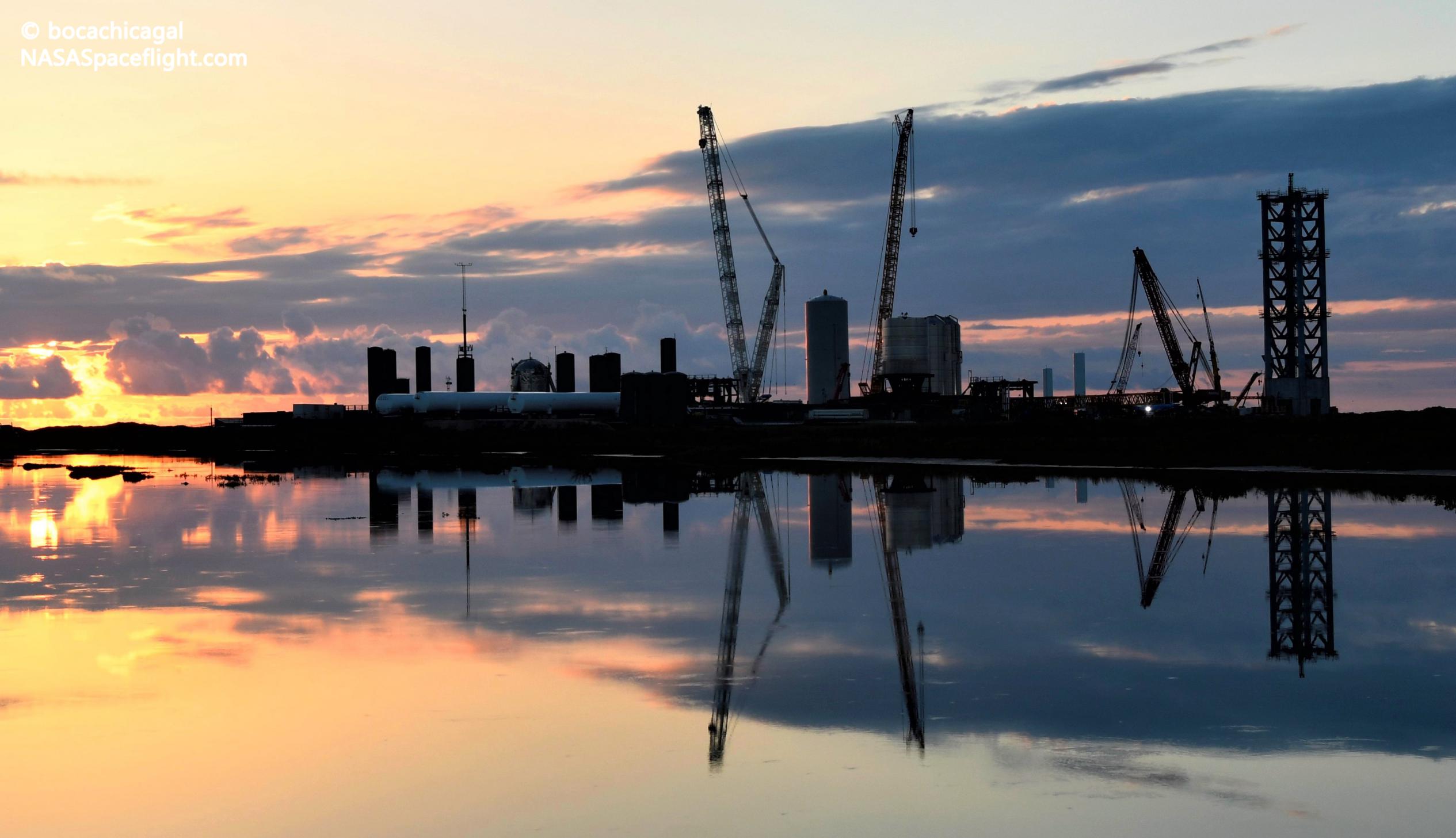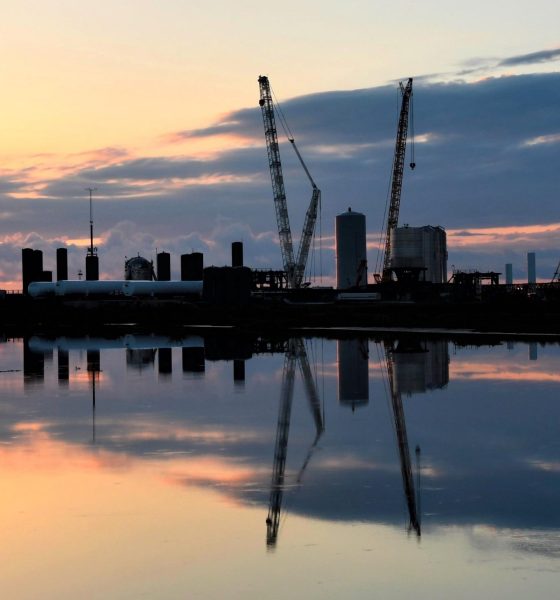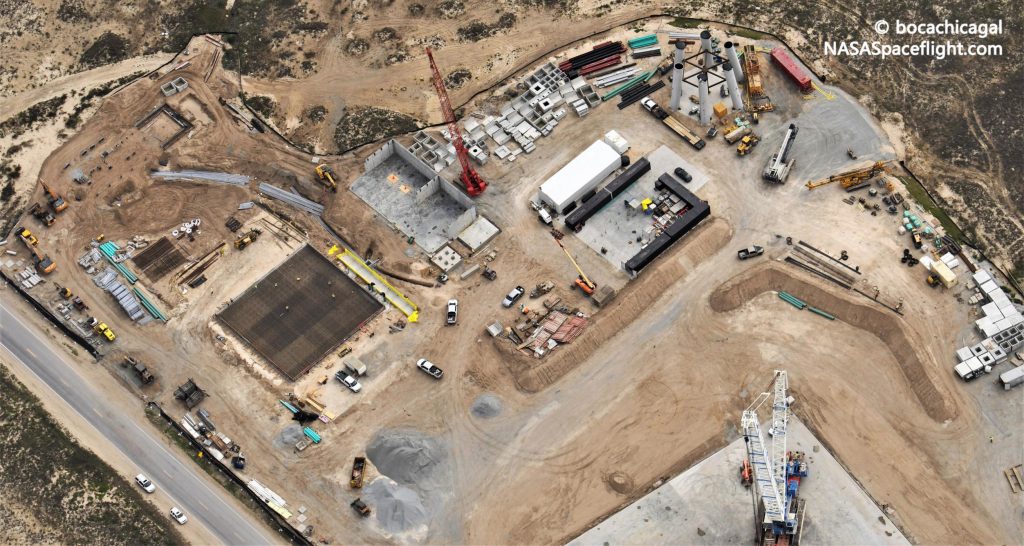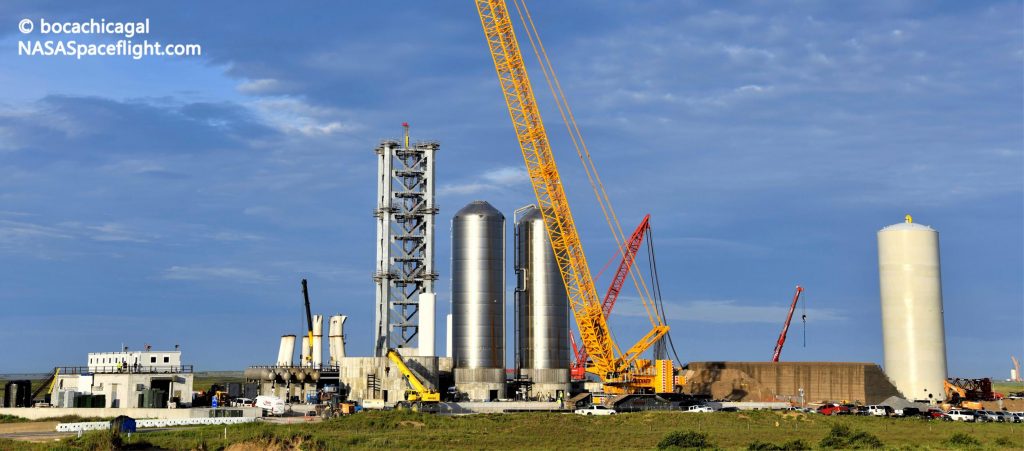

News
SpaceX rolls Starship launch tower section, giant water tank to orbital pad
After a brief pause, SpaceX is once again shipping pad hardware from its Boca Chica, Texas rocket factory to Starship’s rapidly growing orbital launch site (OLS).
A few days of delays aside, the latest transport simultaneously rolled a massive 12m (40 ft) wide water tank and another prefabricated section of SpaceX’s skyscraper-sized orbital launch tower to a nascent orbital launch site adjacent to two well-worn suborbital pads.
Those suborbital pads have been through dozens of ground tests of Starship test tanks, hoppers, and high-altitude prototypes over the last ~20 months, recently culminating in Starship SN15 launching to 10 km (6.2 mi), free-falling back to earth, and becoming the first prototype of its kind to successfully touch down. Since that May 5th milestone, Starship SN15 has been moved to an empty lot – likely to be put permanently on display – and SpaceX’s focus has quite clearly shifted towards Starship’s first orbital test flights.
To even be able to attempt those test flights, which will involve a Starship installed on top of the world’s most powerful rocket booster, several things must be in order. Relative to the three-engine, medium-altitude Starship prototypes SpaceX has the most experience with, CEO Elon Musk has implied that even the very first flightworthy Super Heavy boosters will be outfitted with 29 Raptor engines, representing an almost order-of-magnitude leap in lift-off thrust. In other words, SpaceX’s proven suborbital launch mounts are wholly inadequate for even a rudimentary orbital launch attempt.
Aside from being unable to withstand the immense stress of at least ~5800 metric tons (12.8 million lbf) of thrust, SpaceX’s suborbital pad also has far too little propellant storage capacity to fuel an orbital launch attempt. Enter SpaceX’s first South Texas orbital launch site.

In response, SpaceX has been gradually building out brand new orbital-class launch facilities for around nine months. Work on the pad began to significantly accelerate earlier this year, including the delivery of Starship-derived propellant storage tanks, the rapid assembly of even larger insulation ‘sleeves’ for those custom tanks, the even faster construction of multiple prefabricated launch tower segments, finishing touches on a tall six-legged ‘launch mount,’ the completion of a massive cryogenic propellant pumphouse, miles of wire and pipe runs, and far more.

As it turns out, the second propellant storage tank ‘sleeve’ is actually a massive water tank, indicating that Starship’s first orbital launch site will have some form of water deluge system to limit the damage Super Heavy’s 29 Raptors can do to the pad and rocket itself at liftoff. The tank measures 12m (40ft) wide and approximately 36m (~120ft) tall, meaning that it should be able to hold more than a million gallons (~4000 cubic meters) of water.
Additionally, SpaceX delivered the third prefabricated launch tower segment, leaving the tower more than half its full ~143m (469ft) height once installed. Two more sections are already more than half finished, likely meaning that the tower’s structural skeleton could be fully assembled by July or August.

News
Tesla China delivery centers look packed as 2025 comes to a close
Needless to say, it appears that Tesla China seems intent on ending 2025 on a strong note.

Tesla’s delivery centers in China seem to be absolutely packed as the final days of 2025 wind down, with photos on social media showing delivery locations being filled wall-to-wall with vehicles waiting for their new owners.
Needless to say, it appears that Tesla China seems intent on ending 2025 on a strong note.
Full delivery center hints at year-end demand surge
A recent image from a Chinese delivery center posted by industry watcher @Tslachan on X revealed rows upon rows of freshly prepared Model Y and Model 3 units, some of which were adorned with red bows and teddy bears. Some customers also seem to be looking over their vehicles with Tesla delivery staff.
The images hint at a strong year-end push to clear inventory and deliver as many vehicles as possible. Interestingly enough, several Model Y L vehicles could be seen in the photos, hinting at the demand for the extended wheelbase-six seat variant of the best-selling all-electric crossover.
Strong demand in China
Consumer demand for the Model Y and Model 3 in China seems to be quite notable. This could be inferred from the estimated delivery dates for the Model 3 and Model Y, which have been extended to February 2026 for several variants. Apart from this, the Model Y and Model 3 also continue to rank well in China’s premium EV segment.
From January to November alone, the Model Y took China’s number one spot in the RMB 200,000-RMB 300,000 segment for electric vehicles, selling 359,463 units. The Model 3 sedan took third place, selling 172,392. This is quite impressive considering that both the Model Y and Model 3 are still priced at a premium compared to some of their rivals, such as the Xiaomi SU7 and YU7.
With delivery centers in December being quite busy, it does seem like Tesla China will end the year on a strong note once more.
News
Tesla Giga Berlin draws “red line” over IG Metall union’s 35-hour week demands
Factory manager André Thierig has drawn a “red line” against reducing Giga Berlin’s workweek to 35 hours, while highlighting that Tesla has actually increased its workers’ salaries more substantially than other carmakers in the country.

Tesla Giga Berlin has found itself in a new labor dispute in Germany, where union IG Metall is pushing for adoption of a collective agreement to boost wages and implement changes, such as a 35-hour workweek.
In a comment, Giga Berlin manager André Thierig drew a “red line” against reducing Giga Berlin’s workweek to 35 hours, while highlighting that Tesla has actually increased its workers’ salaries more substantially than other carmakers in the country.
Tesla factory manager’s “red line”
Tesla Germany is expected to hold a works council election in 2026, which André Thierig considers very important. As per the Giga Berlin plant manager, Giga Berlin’s plant expansion plans might be put on hold if the election favors the union. He also spoke against some of the changes that IG Metall is seeking to implement in the factory, like a 35-hour week, as noted in an rbb24 report.
“The discussion about a 35-hour week is a red line for me. We will not cross it,” Theirig said.
“(The election) will determine whether we can continue our successful path in the future in an independent, flexible, and unbureaucratic manner. Personally, I cannot imagine that the decision-makers in the USA will continue to push ahead with the factory expansion if the election results favor IG Metall.”
Giga Berlin’s wage increase
IG Metall district manager Jan Otto told the German news agency DPA that without a collective agreement, Tesla’s wages remain significantly below levels at other German car factories. He noted the company excuses this by referencing its lowest pay grade, but added: “The two lowest pay grades are not even used in car factories.”
In response, Tesla noted that it has raised the wages of Gigafactory Berlin’s workers more than their German competitors. Thierig noted that with a collective agreement, Giga Berlin’s workers would have seen a 2% wage increase this year. But thanks to Tesla not being unionized, Gigafactory Berlin workers were able to receive a 4% increase, as noted in a CarUp report.
“There was a wage increase of 2% this year in the current collective agreement. Because we are in a different economic situation than the industry as a whole, we were able to double the wages – by 4%. Since production started, this corresponds to a wage increase of more than 25% in less than four years,” Thierig stated.
News
Tesla is seeing a lot of momentum from young Koreans in their 20s-30s: report
From January to November, young buyers purchased over 21,000 Teslas, putting it far ahead of fellow imported rivals like BMW and Mercedes-Benz.

Tesla has captured the hearts of South Korea’s 20s-30s demographic, emerging as the group’s top-selling imported car brand in 2025. From January to November, young buyers purchased over 21,000 Teslas, putting it far ahead of fellow imported rivals like BMW and Mercedes-Benz.
Industry experts cited by The Economist attributed this “Tesla frenzy” to fandom culture, where buyers prioritize the brand over traditional car attributes, similar to snapping up the latest iPhone.
Model Y dominates among young buyers
Data from the Korea Imported Automobile Association showed that Tesla sold 21,757 vehicles to the 20s-30s demographic through November, compared to BMW’s 13,666 and Mercedes-Benz’s 6,983. The Model Y led the list overwhelmingly, with variants like the standard and Long Range models topping purchases for both young men and women.
Young men bought around 16,000 Teslas, mostly Model Y (over 15,000 units), followed by Model 3. Young women followed a similar pattern, favoring Model Y (3,888 units) and Model 3 (1,083 units). The Cybertruck saw minimal sales in this group.
The Model Y’s appeal lies in its family-friendly SUV design, 400-500 km range, quick acceleration, and spacious cargo, which is ideal for commuting and leisure. The Model 3, on the other hand, serves as an accessible entry point with lower pricing, which is valuable considering the country’s EV subsidies.
The Tesla boom
Experts described Tesla’s popularity as “fandom culture,” where young buyers embrace the brand despite criticisms from skeptics. Professor Lee Ho-geun called Tesla a “typical early adopter brand,” comparing purchases to iPhones.
Professor Kim Pil-soo noted that young people view Tesla more as a gadget than a car, and they are likely drawn by marketing, subsidies, and perceived value. They also tend to overlook news of numerous recalls, which are mostly over-the-air software updates, and controversies tied to the company.
Tesla’s position as Korea’s top import for 2025 seems secured. As noted by the publication, Tesla’s December sales figures have not been reported yet, but market analysts have suggested that Tesla has all but secured the top spot among the country’s imported cars this year.








